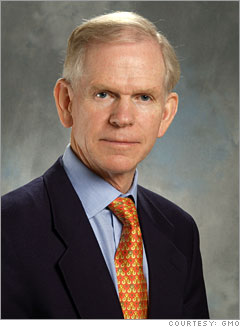Chairman, GMO
The world was moving slowly but very steadily against risk. They've been taking far too much time. The risk premiums had hit a world-record low back in February. It was probably the lowest point in history and across a very broad base of assets. But the essence of the bubble was risk-taking.
It was a bubble of liquidity and a consequence of liquidity.
The proximate cause of this is subprime. That does not seem that profound a problem globally. Of course, unfortunately, that is the local cause. The general cause is that risk was mispriced on an extensive basis globally. By risk, I am referring to elaborate fixed income instruments typified by subprime but also to leveraged debt to private equity, junk bond spreads, credit default swaps. They're using this as an excuse, which they refer to in China as the U.S. subprime problem. But really they're using this as an excuse to reflect the real problem, which is the broad-based mispricing of risk.
The selling might accelerate. On the other hand the markets could easily rally. But in the end risk will be repriced. Whether it's now or in 18 months, risk premiums will be more normal.
The focus of the mispricing is in fixed income. That was more impressive than mispricing in equity markets. But the equity markets were also mispriced. The junky companies were selling at a premium to the blue chips. We had never seen such a deviation in performance between the junky rated companies versus the really high quality companies. It's been going on since September of '02.
The leakage into the equity markets from the fixed income is of course private equity. Private equity is a function of how much debt you can get, the cost of the debt, etc. That fed right through into overpaying for fairly expensive companies. And then of course the ordinary investor, both institutional and individual, began to guess where the next deal would be. And when they saw one, they tried to position around similar ones. That was a real mechanism to feed easy credit and low rates.
I think this is the very early stages of repricing risk, particularly in the stock market. It may be rapidly entering the middle stages in the fixed income market, although I think it will go quite a lot further in the next couple of years. But the equity markets have barely started to address this issue. Still, today the risky stocks are badly mispriced relative to the blue chips. They have a long, long way to go. I have no doubt they will do it. The pendulum always swings completely. In other words, you can guarantee that one day there will be a substantial premium for high quality companies.
There is a lot of pain still to be had in the equity markets, particularly aimed at the risky end of the spectrum. We think the fair value on the market is about a third lower in the U.S and EAFE from today and about a quarter less in emerging markets.
Most of that is not because P/E's are high. The great weakness in equities is that profit margins are off the scale globally. They're off the scale for the same reason that the risk premium got so low--that we've had wonderful global conditions, wonderful global growth, wonderful global liquidity, wonderfully low inflation. That will do it every time, without fail. So the profit margins went steadily up under a constant series of pleasant surprises: Global growth was always a little better than expected, consumption in the U.S. was always a little stronger than expected.
Pleasant surprises are the key to profit margins. If you can put together three years of constant pleasant surprises, you will have fabulous profit margins. It isn't to do with productivity, it isn't to do with China or India. It's to do with pleasant surprises. And of course, the longer the pleasant surprises, the higher the hurdle. The hurdle is now desperately high. It is virtually impossible to pleasantly surprise the world now. And profit margins will of course drift or drop down to normal and below. That's the pressure on the markets. That is what causes the market value to be a third less than it is today.
And people don't get that. People always look at P/E and take great comfort. Often it's perfectly fine to do that. But today it's horribly misleading because the main pain is in profit margins.
In five years, I expect that at least one major bank (broadly defined) will have failed and that up to half the hedge funds and a substantial percentage of the private equity firms in existence today will have simply ceased to exist.
| When Wall Street fails, it asks for a handout. Fortune's Allan Sloan says there must be a better way. (more) But the Treasury Secretary tells Fortune Magazine's Nina Easton that the economy is strong enough to withstand the volatility. (more) |

